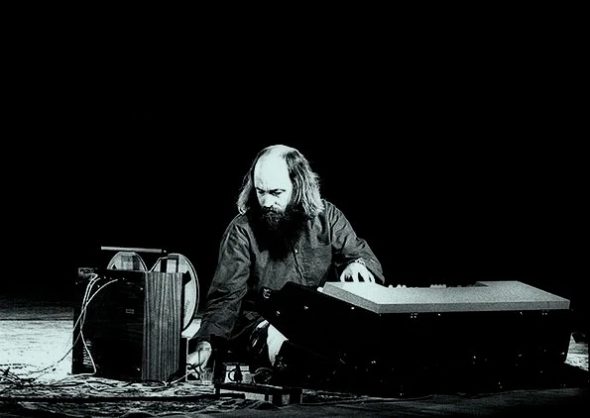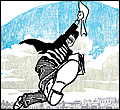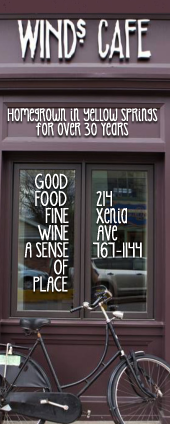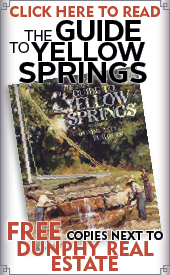
Terry Riley is best known as a pioneer of minimalist composition. Riley's work became notable for its innovative use of repetition, tape music techniques, improvisation and delay systems. (Photo courtesy of last.fm)
Local musicians to bring experimental ‘In C’ to the Emporium
- Published: February 25, 2025
A truly one-of-a-kind musical experience is headed to downtown Yellow Springs next week: The Emporium will host “Neutrals and Friends” — a dozen or so musicians from in and around the village — for a performance of renowned minimalist composer Terry Riley’s ever-changing work “In C,” as well as other compositions, during the weekly wine tasting Friday, Feb. 28, beginning at 7 p.m.
Local music lovers may be familiar with Neutrals — an experimental percussion duo composed of area musicians Evan Miller and Andrew Seivert — from past Porchfest events.
Miller, who spoke with the News last week, said Riley’s “In C” — a formative 1964 minimalist, avant-garde composition noted for its dynamic presentation from performance to performance — fits right in line with the duo’s sensibilities, as well as those of the musicians who will fill out the “Neutrals and Friends” roster, including Yellow Springs musicians Chris Westhoff on guitar and Luke Dennis on bass. It was Westhoff, Miller said, who suggested the group perform “In C” as a kind of tribute to composer Riley, who turns 90 this year.
In addition to Seivert, Westhoff, Dennis and himself, Miller said the chorus of instrumentalists performing “In C” will include “a violinist, a couple of keyboard players, half a dozen percussionists playing various things and a couple other folks from Cincinnati on winds.”
“‘In C’ was written for open instrumentation — it’s for whatever you can get your hands on,” Miller said. “It’ll be quite a fascinating group.”
“In C,” in essence, works like this: A group of musicians read from the same sheet music, which contains 53 fragments of melody in or around the key of C, with each numbered and presented in sequential order, 1–53. Some of the melodic phrases are only one or two notes, with the longest phrase comprising 24 notes.
“The short explanation is that you and your group make your way from one to 53 in order, [with each musician] repeating each phrase however many times — and that’s the piece,” Miller said.
Included with the sheet music are a number of recommendations from composer Riley, who suggests that performers can individually play, repeat and move on to other phrases, in the order they’re presented, at their leisure. Musicians may use any tempo they prefer, but Riley writes that it’s “important not to hurry from pattern to pattern but to stay on a pattern long enough to interlock with other patterns being played.”
“You have to stay sort of close to each other — if I’m on phrase three and someone else is on 10, for example, that’s too far,” Miller said.
The performance notes also suggest that the ensemble “can be aided by the means of an eighth note pulse played on the high C’s of the piano or on a mallet instrument.” Miller noted that famed minimalist composer Steve Reich suggested the “pulse” to Riley as a way to help keep ensembles cohesive as each musician winds their way through the piece. It’s a suggestion that most, if not all, ensembles take — including Riley, in his own 1968 recording of the piece.
“Trying to make your way through this piece without some community understanding of time — I don’t know how anybody would attempt to do it, and I’ve never heard of anybody not using it,” Miller said.
What emerges is a piece of music in which musicians weave in and around one another, drifting apart and coming back together over the course of about 45 minutes, depending on tempo. It’s a composition, Miller said, that requires musicians to listen closely and work together, even as they make their own choices about which phrases to play and for how long.
“You start to get a really quick and dirty understanding of how people play in a piece like this, where there are rules, but a lot of personal decision-making,” Miller said. “Listening really is the key to this.”
And that’s what makes each performance of “In C” unique. Miller said he and Seivert have played the piece before, both at school at Wright State and in other venues, but the joy of the piece for performers, he said, is that if you’ve played it once — well, you’ve played it once. It’ll be different the next time.
“The overlap of the whole thing is where it becomes what it is, and each performance of ‘In C’ is entirely different than any other one that happens,” Miller said. “There’s no way to replicate it exactly from performance to performance.”
That sense of something new every time extends to the audience, too. You may have heard Terry Riley’s 1968 recording of “In C” with the Buffalo Center of the Creative and Performing Arts Ensemble, or any number of other live or recorded performances, but this one won’t be like those — in tempo, in instrumentation, in length or in overall sound. The only thing that will remain the same are the 53 short melodic fragments on sheet music in front of each of the musicians.
“It’s music as an experience,” Miller said. “That’s what’s so exciting about it — every performance is one-of-a-kind.”
For those interested in even more music-as-experience, Miller — the host of WYSO’s experimental music program, “The Outside” — invites all to the next installment of “The Outside Presents” at the Foundry Theater. A free quarterly concert series, “The Outside Presents” aims to expose audiences to experimental music acts from both the Southwest Ohio region and beyond.
“Experimental music is just an idea or an attitude — it’s not a sound,” he said. “It’s just kind of a way of thinking about music-making or an approach to it.”
To that end, the lineup for “The Outside Presents” on March 3 includes Hour, an East Coast instrumental collective headed by Michael Cormier O’Leary. The collective will perform in Yellow Springs as a sextet with guitar, woodwinds, synthesizer and percussion. Performing with the group is New York multi-instrumentalist and singer/songwriter Adelyn Strei, who will also perform her own set, with Hour as her backing band. Also on the bill for March 3 is Cincinnati-based cello player and vocalist Wakefield, known to many as half of the art-punk cello-rock duo Lung.
Miller encourages folks, whether they’re dyed-in-the-wool experimental music fans or completely new to the concept, to come out for both shows, which he said represent the power of what musicians can do collaboratively.
“Groups of people are powerful, and can do inspiring and cool things,” he said. “I’m not saying that Terry Riley’s ‘In C’ on Feb. 28 is going to change the world, but it’s very easy to feel siloed and isolated and alone, and these collective community experiences are important.”
“Neutrals and Friends” will perform Terry Riley’s “In C” and other compositions Friday, Feb. 28, beginning at 7 p.m., at the Emporium; there is a $5 cover charge, with funds to support the performers. “The Outside Presents” will host “We Have Songs to (Sing)” Monday, March 3, beginning at 9 p.m. at Foundry Theater; admission is free.
The Yellow Springs News encourages respectful discussion of this article.
You must login to post a comment.
Don't have a login? Register for a free YSNews.com account.















No comments yet for this article.